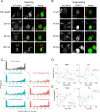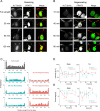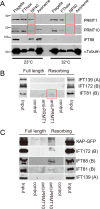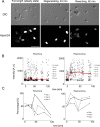Protein arginine methyltransferases interact with intraflagellar transport particles and change location during flagellar growth and resorption
- PMID: 28298486
- PMCID: PMC5415017
- DOI: 10.1091/mbc.E16-11-0774
Protein arginine methyltransferases interact with intraflagellar transport particles and change location during flagellar growth and resorption
Abstract
Changes in protein by posttranslational modifications comprise an important mechanism for the control of many cellular processes. Several flagellar proteins are methylated on arginine residues during flagellar resorption; however, the function is not understood. To learn more about the role of protein methylation during flagellar dynamics, we focused on protein arginine methyltransferases (PRMTs) 1, 3, 5, and 10. These PRMTs localize to the tip of flagella and in a punctate pattern along the length, very similar, but not identical, to that of intraflagellar transport (IFT) components. In addition, we found that PRMT 1 and 3 are also highly enriched at the base of the flagella, and the basal localization of these PRMTs changes during flagellar regeneration and resorption. Proteins with methyl arginine residues are also enriched at the tip and base of flagella, and their localization also changes during flagellar assembly and disassembly. PRMTs are lost from the flagella of fla10-1 cells, which carry a temperature-sensitive mutation in the anterograde motor for IFT. The data define the distribution of specific PRMTs and their target proteins in flagella and demonstrate that PRMTs are cargo for translocation within flagella by the process of IFT.
© 2017 Mizuno and Sloboda. This article is distributed by The American Society for Cell Biology under license from the author(s). Two months after publication it is available to the public under an Attribution–Noncommercial–Share Alike 3.0 Unported Creative Commons License (http://creativecommons.org/licenses/by-nc-sa/3.0).
Figures









Similar articles
-
Methylation of structural components of the axoneme occurs during flagellar disassembly.Biochemistry. 2013 Nov 26;52(47):8501-9. doi: 10.1021/bi4011623. Epub 2013 Nov 12. Biochemistry. 2013. PMID: 24152136
-
Chlamydomonas fla mutants reveal a link between deflagellation and intraflagellar transport.BMC Cell Biol. 2003 Aug 20;4:11. doi: 10.1186/1471-2121-4-11. BMC Cell Biol. 2003. PMID: 12930563 Free PMC article.
-
A protein methylation pathway in Chlamydomonas flagella is active during flagellar resorption.Mol Biol Cell. 2008 Oct;19(10):4319-27. doi: 10.1091/mbc.e08-05-0470. Epub 2008 Aug 13. Mol Biol Cell. 2008. PMID: 18701702 Free PMC article.
-
Intraflagellar transport and the flagellar tip complex.J Cell Biochem. 2005 Feb 1;94(2):266-72. doi: 10.1002/jcb.20323. J Cell Biochem. 2005. PMID: 15558569 Review.
-
The intraflagellar transport machinery of Chlamydomonas reinhardtii.Traffic. 2003 Jul;4(7):435-42. doi: 10.1034/j.1600-0854.2003.t01-1-00103.x. Traffic. 2003. PMID: 12795688 Review.
Cited by
-
Eukaryote-Conserved Methylarginine Is Absent in Diplomonads and Functionally Compensated in Giardia.Mol Biol Evol. 2020 Dec 16;37(12):3525-3549. doi: 10.1093/molbev/msaa186. Mol Biol Evol. 2020. PMID: 32702104 Free PMC article.
-
Composition, structure and function of the eukaryotic flagellum distal tip.Essays Biochem. 2018 Dec 7;62(6):815-828. doi: 10.1042/EBC20180032. Print 2018 Dec 7. Essays Biochem. 2018. PMID: 30464008 Free PMC article. Review.
-
The methylome of motile cilia.Mol Biol Cell. 2024 Jul 1;35(7):ar89. doi: 10.1091/mbc.E24-03-0130. Epub 2024 May 2. Mol Biol Cell. 2024. PMID: 38696262 Free PMC article.
-
Cross-talk between CDK4/6 and SMYD2 regulates gene transcription, tubulin methylation, and ciliogenesis.Sci Adv. 2020 Oct 30;6(44):eabb3154. doi: 10.1126/sciadv.abb3154. Print 2020 Oct. Sci Adv. 2020. PMID: 33127671 Free PMC article.
-
Cilia Distal Domain: Diversity in Evolutionarily Conserved Structures.Cells. 2019 Feb 14;8(2):160. doi: 10.3390/cells8020160. Cells. 2019. PMID: 30769894 Free PMC article. Review.
References
-
- Abramoff MD, Magalhaes PJ, Ram SJ. Image processing with Image J. Biophoton Int. 2004;11:36–42.
MeSH terms
Substances
LinkOut - more resources
Full Text Sources
Other Literature Sources

